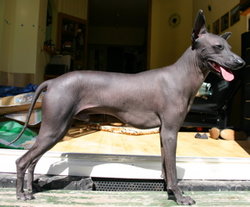
Inca Hairless Dog
Viringo
|
From Wikipedia the free encyclopedia, by MultiMedia |
| Peruvian Hairless Dog | ||
|---|---|---|

|
||
| Alternative names | ||
| Perro Sin Pelo del Perú Inca Hairless Dog Viringo |
||
| Country of origin | ||
| Peru | ||
| Common nicknames | ||
| Classification and breed standards | ||
| FCI: | Group 5 Section 6 #310 | |
| AKC: | Hound (FSS) | |
| Not recognized by any major kennel club | ||
| This breed of Dog is extinct | ||
| Notes | ||
The Peruvian Hairless Dog is a breed of Dog with its origins in Peruvian pre-Inca cultures. It is one of several breeds of hairless Dog.
This is an ancient breed. Although it is often perceived to be an Incan Dog because it is known to have been kept during the Inca-imperium, they were also kept as pets in pre-Inca cultures from the Peruvian coastal zone. Ceramic hairless Dogs from the Chimú, Moche, and Vicus culture are well known. The main area of the Inca imperium (the mountains) is too cold for the natural existence of the Dogs. The Spanish conquest of Peru nearly caused the extinction of the breed. The Dogs survived in rural areas, where the people believed in their magical forces. In recent years, the Fédération Cynologique Internationale (FCI) accepted the breed and adopted an official breed standard. Before that time, in the United States, some enthusiasts created another type of Peruvian hairless Dog, the Peruvian Inca Orchid, which has never been officialy recognized by a major all-breed kennel club.
According to the FCI breed standard, the most important aspect of its appearance is its hairlessnes. The Dog may have short hair on top of its head, on its feet, and on the tip of its tail. In Peru, breeders tend to prefer completely hairless Dogs. The full-coated variety is not recognized as a valid breed variation for the show ring. The color of skin can be chocolate-brown, elephant grey, copper, or mottled. Albinism is not allowed. The eye color is linked to the skin color. It's always brown, but Dogs with light colors can have clearer eyes than darker-skinned Dogs.
Peruvian Hairless Dogs vary in size:
The smallest weighs from 4 kg (9 lb) and the largest up to 25 kg (55 lb). Some kennel clubs consider the three to be separate breeds.
The Dogs should be slim and elegant, with the impression of force and harmony, without being coarse.
The ears should be candleflame shaped and erect with the possibilty to lay flat.
Proportions of height (at withers) to length (withers to base of tail) are 1:1.
The Dogs are very smart, independent, demanding, quick learners, and are loyal and good with children. They are friendly with other Dogs but can be protective as well. These Dogs do not like to be alone, but when trained, can do well. It is a Dog that can be indoors or outdoors. They are agile and fast. Dispite its assets, the primitive nature of the Dog doesn't make it a good Dog for beginners. It needs an owner that understands Dog language.
The lack of hair leads to a reputation for being clean, for being easy to wash with a sponge, and for a natural lack of fleas or other parasites. Despite this, the Dog needs as much care as other Dogs, but in another way. The skin should be taken care of frequently. Almost all of this breed tend to have acne or at least blackheads. The skin often becomes too dry and can be treated with some kind of moisturing cream.
Protection against sunlight may be neccesary, depending on the season and the color of the Dog's skin. The dark-colored Dogs get used to direct sunlight and need to be looked after only in spring when sunlight gets stronger. The light-colored Dogs (copper) and spotted ones have to be protected always, in summer. They tend to quickly sunburn.
Protection against cold is necessary when it gets colder. However, sensitivity to cold may vary from Dog to Dog, with smaller Dogs more sensitive to cold than the bigger ones.
The ears need special attention. The rims of the ears can dry out and chap easily.
The genes that cause hairlessness also result in the breed often having fewer teeth than other breeds, mostly lacking molars and premolars.
One theory is that hairlessness is dominant-lethal, which means that homozygotic hairlesness doesn't exist. This results in a birthrate of 2:1, hairless : coated. However, some breeders don't show this result, having a birthrate between 2:1 and 8:1.
AKC-type breed standards are not compatible with the genetics of hairlessness in Dogs, but FCI rules are. Some breeders think that interbreeding with coated (Peruvian) Dogs is required to maintain functional teeth and nervous system health in subsequent generations. They say that breeding of hairless with hairless (and common but unacknowledged culling of hairy pups from litters to maintain a "pure" image) leads to short-lived Dogs with serious health problems. However, other breeders think the opposite and are doing well, too.
Other than skin-care issues, there are no known health issues to this breed.
It is a persistent myth that the body temperature of hairless Dogs is higher than other Dogs; they may feel warmer due to the lack of hair. Letting the Dog "hug" you is supposed to help with stomach pain and other disorders, according to Peruvian folklore. Other myths are the Dog is a vegetarian or that it cannot bark. It is very likely that some of these myths have helped the breed to survive in Peru.
Dogs, made by MultiMedia | Free content and software
This guide is licensed under the GNU Free Documentation License. It uses material from the Wikipedia.